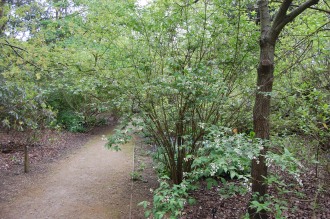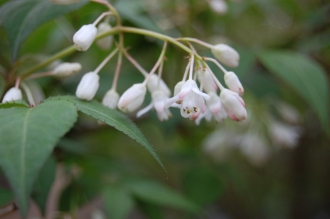Position: Full sun to dappled shade
Flowering period: Late spring
Soil: Moist, well drained
Eventual Height: 1.8m
Eventual Spread: 1.8m
Hardiness: 5b, 6a, 6b, 7a, 7b, 8a, 8b
Family: Staphyleaceae
Staphylea bumalda is a deciduous shrub/ small tree with an upright habit. Its mid to dark green leaves are trifoliate. Its leaflets are elliptic to ovate with serrulate margins, up to 8cm long and 5.5cm broad. Its fragrant white flowers are bell shape, up to 1cm across and appear as erect terminal panicles which are up to 12cm long. Its green/ white fruit are bladder like and up to 25mm long. Its roots produce suckers which aids its spread.
Staphylea bumalda, commonly known Bumald Bladdernut or Japanes Bladdernut, is native to Japan, east China and Korea. In its native habitat it grows within and at the edges of open deciduous forests, usually close to streams.
The etymological root of the binomial name Staphylea is derived from the Greek staphyle meaning ‘cluster’ in reference to its flowers. Bumalda may be named after Ovidio Mantalbani, 17th century Italian professor, reader feedback would be welcome.
The landscape architect may find Staphylea bumalda useful as a fragrant flowering shrub which tolerated dappled shade, particularly good for an open woodland setting.
Ecologically, Staphylea bumalda flowers are attractive to pollinating insects.
Staphylea bumalda prefers moist, fertile, well-drained soils. It tolerates most pH of soil. It dislikes dry soils.
Staphylea bumalda requires little maintenance.







Originally described by Thunberg in 1783 as Bumalda trifolia, apparently named for Ovidio Monalbani (1601-1671) who wrote under the pseudonym Giovanni Antonio Bumaldi.